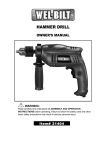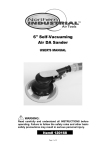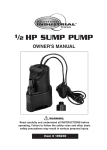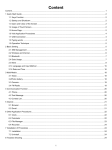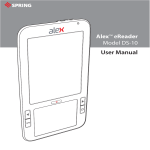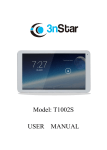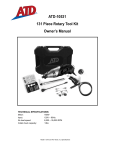Download Wel-Bilt 21405 Owner`s manual
Transcript
JIG SAW OWNER’S MANUAL WARNING: Read carefully and understand all ASSEMBLY AND OPERATION INSTRUCTIONS before operating. Failure to follow the safety rules and other basic safety precautions may result in serious personal injury. Item# 21405 Thank you very much for choosing a Wel-Bilt™ product! For future reference, please complete the owner’s record below: Model: _______________ Purchase Date: _______________ Save the receipt, warranty and these instructions. It is important that you read the entire manual to become familiar with this product before you begin using it. This machine is designed for certain applications only. The distributor cannot be responsible for issues arising from modification. We strongly recommend this machine not be modified and/or used for any application other than that for which it was designed. If you have any questions relative to a particular application, DO NOT use the machine until you have first contacted the distributor to determine if it can or should be performed on the product. For technical questions please call 1-800-222-5381. INTENDED USE: Your Wel-Bilt Jig Saw has been designed to cut accurately through plastic, wood and thin metals. It allows you to make straight or curved cuts when used in a DIY (Do It Yourself) context or for hobbyist purposes. It is not designed for commercial or industrial operations TECHNICAL SPECIFICATIONS: Input current: Input voltage: No load speed: Cutting capacity in plate steel at 90°: Cutting capacity in round wood and plastic at 90°: Stroke length: 3.2A 120Volt~60Hz 3000 RPM 1/4in. 2in. 3/4in. GENERAL SAFETY RULES WARNING: Read and understand all instructions. Failure to follow all instructions listed below may result in serious injury. CAUTION: Do not allow persons to operate or assemble this Jig Saw until they have read this manual and have developed a thorough understanding of how the Jig Saw works. WARNING: The warnings, cautions, and instructions discussed in this instruction manual cannot cover all possible conditions or situations that could occur. It must be understood by the operator that common sense and caution are factors which cannot be built into this product, but must be supplied by the operator. SAVE THESE INSTRUCTIONS Page 2 of 10 IMPORTANT SAFETY CONSIDERATIONS • Stay alert, watch what you are doing and use common sense when operating the Jig Saw. Do not use the Jig Saw while you are tired or under the influence of drugs, alcohol or medication. A moment of inattention while operating the Jig Saw may result in serious personal injury. • Dress properly. Do not wear loose clothing, dangling objects, or jewelry. Keep your hair, clothing and gloves away from moving parts. Loose clothes, jewelry or long hair can be caught in moving parts. Air vents often cover moving parts and should be avoided. • Use safety apparel and equipment. Use ANSI-approved safety goggles or safety glasses with side shields, or when needed, a face shield. Use as dust mask in dusty work conditions. This applies to all persons in the work area. Also use non-skid safety shoes, hardhat, gloves, dust collection systems, and hearing protection when appropriate. • Do not overreach. Keep proper footing and balance at all times. • Remove adjusting keys or wrenches before connecting to the power supply or turning on the tool. A wrench or key that is left attached to a rotating part of the tool may result in personal injury. JIG SAW USE AND CARE • Do not modify the Jig Saw in any way. Unauthorized modification may impair the function and/or safety and could affect the life of the equipment. There are specific applications for which Jig Saw was designed. • Always check of damaged or worn out parts before using the Jig Saw. Broken parts will affect the Jig Saw operation. Replace or repair damaged or worn parts immediately. • Store idle Jig Saw. When Jig Saw is not in use, store it in a secure place out of the reach of children. Inspect it for good working condition prior to storage and before reuse. Page 3 of 10 ASSEMBLY The shoe of this Jig Saw can be tilted up to 45º to the left or to the right, allowing the Jig Saw to cut at any angle between these two limits. Page 4 of 10 The Jig Saw is supplied with a hex key housed in an on board storage clip. This hex key is the only tool required to adjust the angle of the shoe and to fit or remove a blade. Fig A Before using the machine, carefully read these instructions, especially the safety rules to help ensure that your machine always operates properly. Before attempting to operate the machine, familiarize yourself with the controls and make sure you know how to stop the machine quickly in an emergency. Save these instructions and the other documents supplied with this machine for future reference. Selecting the right Jig Saw blade Your Jig Saw has the ability to use a number of different types of interchangeable blades. The type of material cut, along with the desired quality of finish, typically determines the type of blade used. Blade fitment type There are basically two types of Jig Saw blade fitments: T-shaped (or bayonet) and U-shaped (or universal). Your Jig Saw utilizes T-shaped fitments. Please ensure that you purchase only this type, as U-shaped fitment blades cannot be securely attached. Blade material Three basic types of materials are used for Jig Saw blades. High-speed steel blades are usually the best choice for cutting all types of wood products. Cobalt steel blades hold up better when cutting metal products. Carbide grit blades are designed for working with such materials as ceramic tiles and masonry board. Teeth Per Inch Jig Saw blades are frequently rated in teeth per inch. A general rule is that blades with a lower number of teeth per inch are better for quick, rough cuts on soft materials. Blades with a higher number of teeth per inch are designed for harder materials. Blades with a higher number of teeth per inch make a finer cut but also cut more slowly than blades with fewer teeth per inch. Before purchasing new blades Please check on the blade packaging for the suitability of the blade for the job at hand. Inserting a blade 1. Before performing any adjustments ensure the tool has been switched off and is disconnected from any power supply. 2. Turn the Jig Saw upside down and slide the dust shield towards the shoe as far as it will go. Fig B This makes it easier to access both of the blade securing bolts. 3. Remove the hex key from its holder and use this key to loosen the two blade securing bolts. The bolts can be accessed through the open slots in the dust shield. Fig C 4. Insert the shaft end of the blade through the shoe into the blade holder. Ensure the teeth of the blade face towards the front of the saw. Fig D 5. When the blade is inserted as far as it will go, secure it in place by tightening the bolts Page 5 of 10 clockwise. 6. Check that the back edge (non-serrated edge) of the blade is within the groove of the blade guide wheel. If it is not, use the hex key to loosen the two bolts that secure the shoe and adjust the position of the shoe so that the back of the blade is firmly supported by the blade guide wheel. Fig E Tighten the shoe locking screws. 7. Return the dust shield into position. 8. Connect the Jig Saw to the power supply, switch on and check that the blade runs correctly. Switch off. Removing a blade 1. Before performing any adjustments ensure the tool has been switched off and is disconnected from any power supply. 2. Turn the Jig Saw upside down, slide the dust shield towards the shoe and use the hex key to loosen the two blade securing bolts. 3. Remove the blade through the gap in the shoe. Adjusting the angle of the shoe 1. The shoe can be tilted to angles between 0°-45° left or right so that you can cut bevel angles in a work piece. 2. Before performing any adjustments ensure the tool has been switched off and is disconnected from any power supply. 3. Turn the Jig Saw upside down and use the hex key to loosen the shoe locking screws that secure the shoe. Fig E 4. Slide the shoe backwards away from the blade. 5. Tilt the shoe between 0° and 45° left or right. Bevel angles of 0, 15, 30 and 45º are marked on the bevel scale. Fig F Once the angle has been set, slide the shoe forwards again and tighten the shoe locking screws. If an accurate bevel is required, it is best to check the setting with a protractor or by making a trial cut in a piece of scrap material and re-adjusting the setting if necessary. Fig G OPERATION: 1.The shoe should always be kept flat against the work piece when performing a cut. 2. Take care to always select the correct blade for the job on hand. Cutting on a straight or curved line 1. Mark your cutting line with a pencil or other suitable marker. 2. Start the tool by squeezing the on/off switch trigger and wait a few seconds until the blade achieves maximum speed. Fig H 3. Place the shoe on the work piece and move forward slowly along the cutting line. Take extra care and time when cutting curved lines in order to reduce stress on the blade and the chance of breaking it. Let the tool work at its own pace. Do not overload the tool by pushing hard into the cut. Page 6 of 10 4. For sustained cutting, you can press the lock-on switch to keep the trigger switch engaged. To release the lock on switch press the trigger switch then release it. Fig I Cutting metal 1. Your Jig Saw can be used for cutting light gauge ferrous sheet and non-ferrous metals such 2. When cutting sheet metal, clamp it to a backing sheet of soft wood or plywood. as copper, brass and aluminum. The metal and its wood backing are then sawn together. This gives a clean cut without vibration and prevents the metal from tearing. 3. Do not force the cutting blade into the metal as this will reduce the life of the blade and possibly damage the motor. 4. Cutting thin metal takes longer than cutting even a relatively thick piece of wood, so do not be tempted to speed up the operation by forcing the saw. 5. Spread a thin film of oil along the proposed cutting line before commencing to saw metal. Pocket and round cutting 1. When you need to make a cut in the middle of a work piece without cutting into the edge, first the drill a hole inside the marked line of the cut, using a 1/2in. drill bit. This allows the blade to pass through the hole in order to begin the cut. When cutting tight curves, reduce the speed of the Jig Saw. Dust Extraction The tool can be attached to most portable vacuum cleaners via the dust extraction port. MAINTENANCE • Maintain your Jig Saw. It is recommended that the general condition of any Jig Saw be examined before it is used. Keep your Jig Saw in good repair by adopting a program of conscientious repair and maintenance. Have necessary repairs made by qualified service personnel. • Your tool has been designed to operate over a long period of time with a minimum of maintenance. Continuous satisfactory operation depends upon proper tool care and regular cleaning. WARNING! Before performing any maintenance, switch off and remove the electrical plug from the outlet. 1. After each use, blow air through the tool housing to ensure it is free from all dust particles that may build up. Build up of dust particles may cause the tool to overheat and fail. 2. If the body of the tool requires cleaning do not use solvents but a moist soft cloth only. Never let any liquid get inside the tool; never immerse any part of the tool into a liquid. 3. When the carbon brushes wear out the tool will spark and/or stop. The brushes are a wearing component of the tool and should be replaced prior to the carbon wearing out fully. Brushes will wear out after many uses but before they do take the tool to an electrician or a power tool repairer for quick and low cost replacement. Always replace both brushes at the same time. Page 7 of 10 PART LIST Part# Description Part# Description 1 Cord 20 Cropper 2 Cord sleeve 21 Flat 3 Cord clamp 22 Sliding 4 Screw 23 Bearing 5 Switch 24 Rotor 6 Left housing 25 Brush holder 7 Square nut 26 Brush 8 Roller 27 Bearing 9 Baseplate securing 28 Stator 10 Baseplate 29 Hex screw 11 Slide 30 Spring washer 12 Flange 31 Blade 13 screw 32 Oil proof washer 14 Baffle 33 Saw 15 slide block 34 Screw 16 Reciprocating bar 35 Left housing 17 Steel bush 36 Screw 18 Gear 37 Label 19 Gear support block pin Page 8 of 10 sinter washer block holder blade For replacement parts and technical questions, please call 1-800-222-5381. Page 9 of 10 WARNING Some dust created by power sanding, sawing, grinding, drilling, and other construction activities contains chemicals known to the State of California to cause cancer, birth defects or other reproductive harm. Some examples of these chemicals are: • lead from lead-based paints, • crystalline silica from bricks and cement and other masonry products, and • arsenic and chromium from chemically treated lumber. Your risk from these exposures varies, depending on how often you do this type of work. To reduce your exposure to these chemicals: work in a well-ventilated area, and work with approved safety equipment, such as those dust masks that are specially designed to filter out microscopic particles. Distributed by Northern Tool + Equipment Co., Inc. Burnsville, Minnesota 55306-6936 Made in China Page 10of 10










